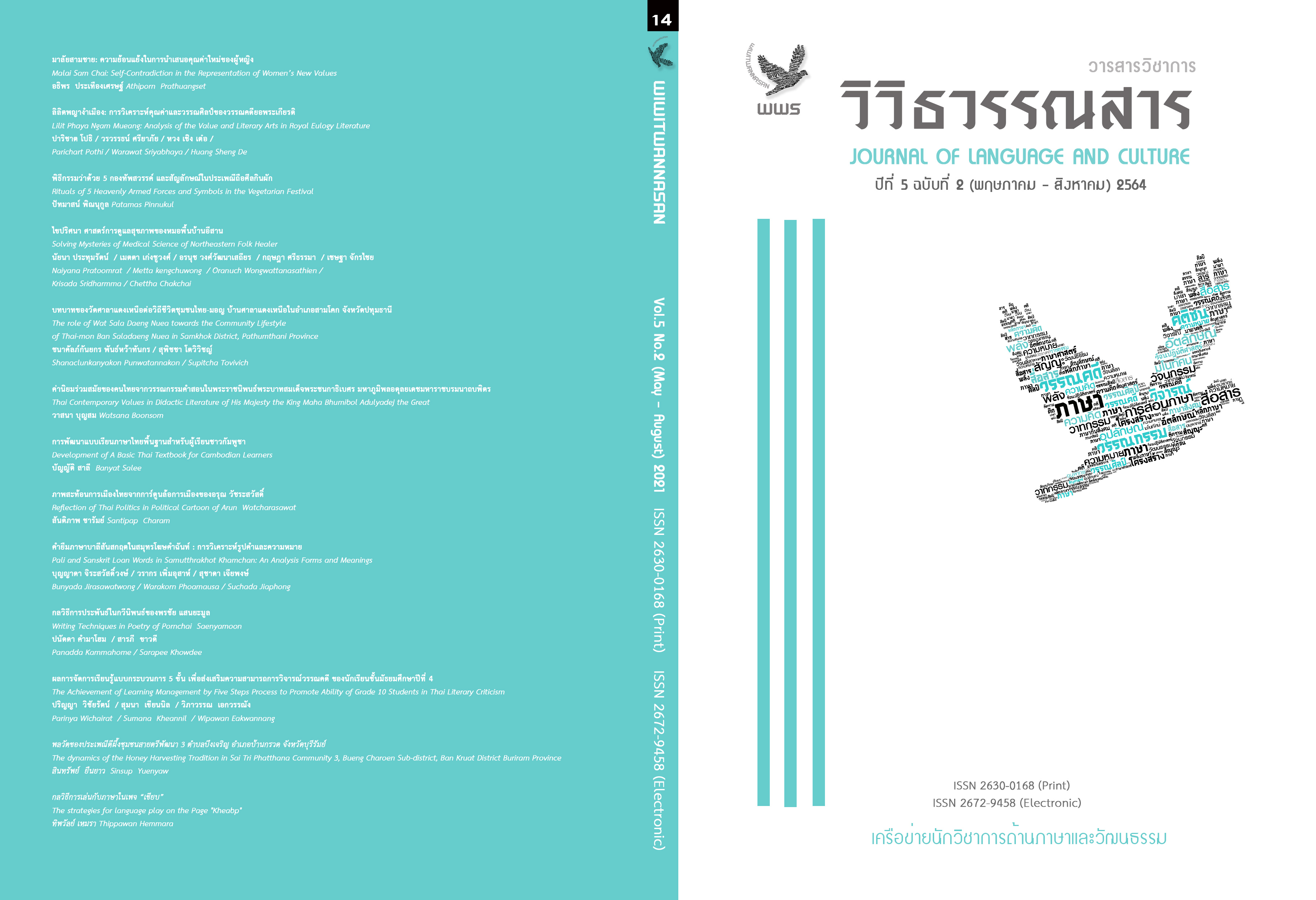มาลัยสามชาย: ความย้อนแย้งในการนำเสนอคุณค่าใหม่ของผู้หญิง
Main Article Content
บทคัดย่อ
บทคัดย่อ
บทความนี้วิเคราะห์นวนิยายอิงประวัติศาสตร์ เรื่อง มาลัยสามชาย ของ ว.วินิจฉัยกุล เพื่อชี้ให้เห็นว่า ในขณะที่ผู้ประพันธ์มุ่งหักล้างความคิดเกี่ยวกับผู้หญิงที่ว่าผู้หญิงที่แต่งงาน 3 ครั้งเป็นผู้หญิงที่ไม่ดี และนำเสนอคุณค่าใหม่เกี่ยวกับผู้หญิงว่า คุณค่าของผู้หญิงมิได้ขึ้นอยู่กับการแต่งงาน และผู้หญิงสามารถกำหนดเส้นทางชีวิตได้ด้วยตนเองนั้น นวนิยายเรื่องนี้กลับเป็นการผลิตซ้ำชุดความคิดเกี่ยวกับ “กุลสตรี” ในหลายประเด็น ได้แก่ การเกิดในชาติตระกูลสูง คุณสมบัติของการเป็นแม่ศรีเรือน ปรนนิบัติสามีเรื่องภายในบ้านทุกอย่าง ความซื่อสัตย์และจงรักภักดีต่อสามี นอกจากนี้ยังแฝงการวิพากษ์ความเปลี่ยนแปลงทางการเมืองการปกครองจากระบอบสมบูรณาญาสิทธิราชย์ไปสู่ระบอบประชาธิปไตย ผู้ประพันธ์นำเสนอชุดความคิดเหล่านี้ผ่านกลวิธีสำคัญ 3 ประการ ได้แก่ 1) การสร้างตัวละครเอก คือ ลอออร ให้มีคุณสมบัติของ “ผู้หญิงก้าวหน้าที่อยู่ในกรอบ” 2) การสร้างตัวละครคู่เปรียบ คือ ทองไพรำ ในฐานะ “หญิงร้าย” และ 3) การใช้เหตุการณ์เปลี่ยนแปลงการปกครองพุทธศักราช 2475 มาสร้างปมปัญหาที่ส่งผลกระทบต่อชีวิตคู่ของลอออร นวนิยายเรื่องนี้จึงแสดงให้เห็น “ความย้อนแย้ง” ของการนำเสนอคุณค่าใหม่ของผู้หญิงที่ยังคงติดอยู่กับคำอธิบายเรื่องความเป็นกุลสตรี เมื่อนำแนวคิดสังคมวิทยาแห่งวรรณคดีมาวิเคราะห์ปัจจัยที่น่าจะสัมพันธ์กับการนำเสนอชุดความคิดดังกล่าวในนวนิยายเรื่องนี้แล้วพบว่ามี 4 ปัจจัย ได้แก่ 1) ปัจจัยด้านผู้ประพันธ์ คือ ทัศนะของผู้ประพันธ์ที่ยึดถือในคุณค่าของความเป็นไทยแบบจารีต 2) รูปแบบการนำเสนอของนวนิยายที่อยู่ในรูปของชีวประวัติ ซึ่งผู้ประพันธ์ได้รับแรงบันดาลใจในการแต่งจากการได้รับฟังชีวประวัติของสตรีอาวุโสท่านหนึ่งที่ผู้ประพันธ์รู้จัก 3) ฉากของนวนิยาย และ 4) ปัจจัยด้านการเผยแพร่นวนิยาย กล่าวคือกลุ่มผู้อ่านที่น่าจะนิยมอ่านนวนิยายของ ว.วินิจฉัยกุล เป็นกลุ่มผู้หญิงชนชั้นกลาง ที่นำเสนอชุดความคิดในลักษณะคล้ายคลึงกับเรื่องมาลัยสามชาย
Article Details
ลิขสิทธิ์ของบทความเป็นของวารสาร การพิมพ์ซ้ำจะต้องได้ร้บการอนุญาตจากบรรณาธิการวารสาร
เอกสารอ้างอิง
Boonkhachorn, T. (1999). “Cha ao niyay a rai” chak prawatsart nai nawaniyay? (in Thai) [What kind of fiction does we expect from historical novels]. Art and Culture Magazine, 21 (1), 84-88.
Chaloemtiarana, T. (2015). Aan chon taek (in Thai) [Read till it shatters Nationalism and identity in modern Thai Literature]. Bangkok: Aan.
Chantavanich, S. (1983). Sangkomwittaya wannakhadi (in Thai) [Sociology of Literature]. Bangkok: Sociology and Anthropology Department, Faculty of Political Science, Chulalongkorn University.
Ditheeyont, W. (1996). Bueang lang ‘rattanakosin’: Kan nam wi thi wichai machai nai kan taeng nawaniyay ingprawatsart (in Thai) [The making of Rattanakosin and application of methodology in writing historical novels]. Silpakorn University Journal, 8 (1), 29-40.
Intaraporn, W. (2009). Sappha Li Huan: Kan suek sa nai ngae sungkomwitthaya wannakhadi (in Thai) [Sappha Li Huan: The Study in the Sociology of Literature]. Songkla: Faculty of Liberal Arts, Prince of Songkla University.
Jaroenjitrkam, P. (1984). Kan suek sa nawaniyay ingprawatsart thai ra wang phuttasakkalat 2490-2525 (in Thai) [An Analytical Study of Historical Novels during 1947-1982 A.D.]. Bangkok: Thammasat University.
Prakitnonthakarn, C. (2003). Chak ‘Sayam kao’ su ‘Thaimai’: Khwam may thang sungkom lae kanmueang nai ngan sathapattayakam phuttasakkalat 2394-2500 (in Thai) [From Old-siam to New-Thai: Social and Political meanings in Architecture during 1892-1957 A.D.] (Master’s thesis). Chulalongkorn University, Bangkok.
Suklarpkit, S. (2018). Phua diaw mia diaw: a na ni khom khop khua nai Sayam (in Thai) [Monogamy: family colonial in Siam]. Bangkok: Matichon.
Tanaprasitpatana, S. (1991). Sathanaphap thang sangkhom khong sattri thai nai samai patirup prathet (in Thai) [Social status of thai woman during the reformation period]. Journal of Letters, 23 (2), 3-19.
Varatorn, S. (1976). Prawat kan praphan nawaniyay thai tangtae samai reakroem chonthueng phuttasakkalat 2475 (in Thai) [History of Thai novels from the beginning to 1932 A.D.]. Bangkok: The Foundation for the Promotion of Social Sciences and Humanities Textbooks Project.
V.Vinicchayakul, Malai Sam Chai (in Thai) [A Three-tasseled Garland] (8th ed.).Bangkok: Aksornsophon.
Yongsiri, S. (2002). Kan sueksa choeng wikho nawaniyay ingprawatsart samai rattanakosin (in Thai) [An Analytical Study of Rattanakosin Historical Novels] (Master’s thesis). Chulalongkorn University, Bangkok.


